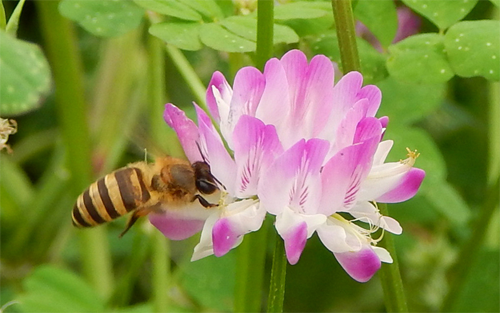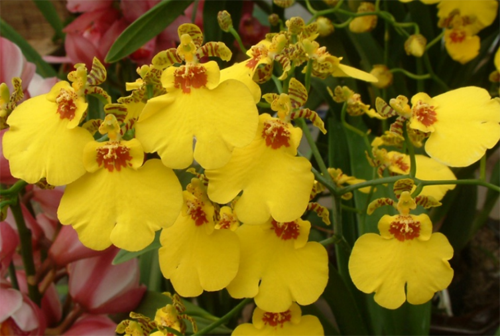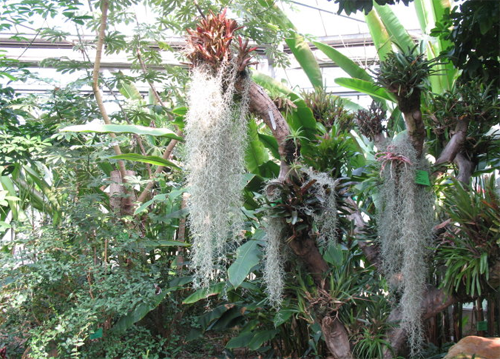The seed germination temperature of Chinese milk vetch
Chinese milk vetch flowers are very good-looking purple, is very lovely, sometimes in the roadside can see, is very attractive, Chinese milk vetch breeding method is what kind of it? What is the temperature suitable for seed germination?

The cultivation method of Chinese milk vetch:
1. Timely sowing
Chinese milk vetch likes cool climate, can sow in late autumn, prepare basin soil before sowing, prevent ponding, irrigate dry soil once, seed should be sun-dried (sun-dried for half a day), wiped (seed abraded skin becomes smooth on the line), soaked (soak in clear water for a day, it is easy to germinate).
2. Appropriate fertilization
Fertilization on the line of ordinary compound fertilizer,"winter solstice" around, apply a little potassium fertilizer, improve seedling cold resistance. "Spring" after a little fertilization, warm spring after the branches and leaves will grow, growth period to keep moist, prevent ponding on the line.
Pest protection:
Powdery mildew was the main disease, which could be controlled by spraying with 0.05% Tuijunte (or carbendazim).
Insect pests have aphids, thrips, available dimethoate control; armyworm directly pinched to death.
Chinese milk vetch profile:
There are other names of Chinese milk vetch: Qiao Yao, red flowers, some places can see a large, full of red.
Chinese milk vetch likes a warm, slightly moist environment, it is best to grow in moist, well-drained soil, so it grows best, the ability to withstand shade at the seedling stage is strong, people often plant this flower for a period of time, and then plant crops.
Chinese milk vetch it is not too cold, there is an obvious winter period, seedling stage below 8℃ growth slow, after the spring, the daily average temperature reached 6℃~8℃ above, the growth rate will be significantly accelerated.
The optimum temperature for flowering and fruiting was 13℃~20℃. Chinese milk vetch grows well in moist and well-drained soil, afraid of early and afraid of soiling. The most suitable soil for growth is slightly moist, and the soil is mainly light loam.
The plant height of Chinese milk vetch grows slowly at seedling stage, and increases gradually with temperature rising after spring, and increases rapidly after bud stage, and the growth speed is the fastest from initial flower to full bloom stage, and the length of plant height increase from bud stage to full bloom stage accounts for about two thirds of the final bloom stage.
The flowering period of Astragalus sinicus is generally 30~40 days. The flowers of the main stem and the first pair of large branches at the base open first, and then open in sequence according to the order of branches. The main stem and branches are opened one by one from the bottom to the top. The natural hybridization rate of Astragalus sinicus is very high, generally more than 60%. It usually takes about 20 to 30 days for the pod to bloom and turn black.
Germination temperature of Chinese milk vetch seeds:
The suitable temperature for seed germination was 15℃~25℃, and the germination needed to absorb more water and oxygen.
About the introduction of Chinese milk vetch here, like the little friends, hurry up in their own yard to a few plants.
The introduction of Chinese milk vetch cultivation method
Chinese milk vetch is distributed in the Yangtze River region of China. It grows in areas with an altitude of 400 meters to 3000 meters. It grows mostly in streams, hillsides and wet places. At present, many areas in the country vigorously promote the cultivation of Chinese milk vetch. Let's take a look at the relevant knowledge of Chinese milk vetch.
1. Introduction of Chinese milk vetch
Chinese milk vetch, also known as Qiao Yao, red flowers, grass seed, native to China. Chinese milk vetch likes warm and humid conditions, has a certain cold resistance, requires enough water during the whole growth period, Chinese milk vetch is not strict with soil requirements, and is suitable for sandy and clay loam. Salt tolerance is poor, belongs to leguminous, Astragalus genus. Chinese milk vetch is a biennial herb. Taproot is more hypertrophy, lateral roots into the soil is shallow, stems were cylindrical, hollow, tender and juicy, there are sparse velutinous. Leaves are mostly odd-numbered pinnate compound leaves, flowers are umbels, generally axillary, less terminal, pods in two rows, united into a triangle, seeds reniform, seed coat smooth, roots, whole grass and seeds can be used as medicine, there are Qufeng eyesight, spleen qi, detoxification analgesic effect. Chinese milk vetch is a leguminous plant belonging to Astragalus genus, mainly used for fertile farmland and flower ornamental. It is now distributed in central and western Asia and is cultivated as green manure for rice fields. As early as Ming and Qing Dynasties, it has been planted in the middle and lower reaches of Yangtze River in China. It is widely distributed in the area of 24~35 ° N. It is one of the main nectar plants in China.
2. Cultivation methods of Chinese milk vetch
maintenance points
1. timely sowing
Chinese milk vetch likes cool climate, can be sown in late rice full heading period, that is, about 25 days before harvest, sowing amount per mu 1.5 kg, rice field should be exposed before sowing, prevent ponding, dry field should be irrigated once. Seeds should be sun-dried, rubbed (ground) seeds and soaked. Sunning seeds can promote the activity of enzymes in seeds and improve the germination rate of seeds. Generally, it can be sunned for half a day. Rubbing (grinding) seeds can rub (grind) the waxy layer on the surface of seeds to make seeds easy to absorb water. Coarse sand can be used to mix seeds. Grasp the seeds and sand with hands, or gently grind them with rice mill until the seed epidermis is smooth. Soaking seeds can accelerate seed coat softening, promote seed germination, make germination fast and neat, soak 12-24 hours can be picked up after drying for germination, pay attention to dry fields do not soak seeds, in case of water shortage after sowing buds dry.
2. Rhizobia
After germination, mix rhizobia when exposing white, mix with cold porridge soup and seed dressing, 0.5 kg Astragalus rhizobia strain can be mixed with 7.5 kg Astragalus seeds, sow 5 mu.
3. timely fertilization
Phosphorus and potash fertilizer were mainly applied, and nitrogen fertilizer was properly matched. After late rice harvest, 10-15 kg of calcium superphosphate and 1000 kg of manure water were applied per mu to promote early nodule formation and early seedling development. Before and after the winter solstice, 3-4 kg of potassium fertilizer or 50 kg of plant ash were applied per mu to improve the cold resistance of seedlings. After the "beginning of spring", urea is applied 3-5 kg per mu to accelerate the rapid growth of branches and leaves after warm spring and improve the yield of fresh seedlings.
4. strengthen field management
After late rice harvest, open ring ditch, box ditch and cross drainage ditch in time, keep wet in the early stage to prevent ponding (especially in the later stage); main diseases are powdery mildew, which can be sprayed with 0.05% Tuijunte (or carbendazim); pests are aphids and thrips, which can be controlled with dimethoate. The armyworm was controlled with 90% trichlorfon 100g, rice vinegar 150ml and saccharin 5g per mu against 75kg water. In order to improve the pod bearing rate, attention should be paid to prevent thrips from damaging in full bloom. At the same time, avoid livestock damage.
5. timely green pressing
Generally, green pressing is carried out 15-20 days before early planting in full bloom. Lime is applied 25-40 kg per mu to promote the decomposition of Chinese milk vetch and neutralize acidity.
How to sow Chinese milk vetch seeds, Chinese milk vetch propagation method/do a good job of keeping warm and moisturizing
In the cultivation method of Chinese milk vetch, reproduction is a very important link, because it is related to the growth of Chinese milk vetch after the robust, Chinese milk vetch belongs to Astragalus plants, its reproduction method and some plants slightly different, then how Chinese milk vetch reproduction? How do you sow seeds? Xiao Bian is here to share with you the breeding method of Chinese milk vetch.
How to reproduce Chinese milk vetch
Because Chinese milk vetch is a common ecological feed, in addition to it belongs to biennial herbs, usually it is used for large-scale reproduction of farmland, so in the breeding method mainly used in the way of sowing, although simply said is to sow seeds on the sand bed, but sowing time, drying seeds, seed selection, late maintenance and so on are very important, below we will introduce some of its sowing methods in detail.
How to sow seeds.
I. Sowing time
Generally, the seeds will be sown from late September to early October, because if the seeds are sown too early, the seedlings will be thin, and too late, because winter is coming, the seedlings will be easily frostbitten, so September-October is the most ideal time.
II. Sowing method
1. Seed selection and drying
In the propagation method of Chinese milk vetch, sowing is the most commonly used, but the technique is also very critical. The selected seeds should be full of particles, so that the seedlings will be more robust. After selection, the seeds need to be dried by spreading them in the sun for 4-5 hours, which can promote the activity of enzymes in the seeds.
2. Soak seeds and dry
After drying seeds, fine sand can be added to the seeds, which can wipe off the wax on the surface of the seeds, thus improving the germination rate of seeds after sowing. After that, the seeds are soaked in water or 0.1-0.2% potassium dihydrogen phosphate solution for about 10 hours, taken out and dried, and mixed with calcium magnesium phosphate.
3, evenly seeded
Sow the seeds evenly on the sand bed, generally 1.5-2 kg per mu, keep the soil moist after sowing, and then cover with straw for heat preservation and moisture, which can promote rapid rooting and germination of seeds.
Tips for breeding Chinese milk vetch
1. Temperature control
The best temperature for the germination of Chinese milk vetch seeds is 15-25 degrees Celsius, and the germination stage requires a lot of moisture and yang, so it is necessary to keep warm and moist during sowing, to prevent the soil from being too dry, and to ensure that the soil is well ventilated.
2. Do not accumulate water
Although it is necessary to ensure that the soil is moist during germination, there must be no accumulated water, otherwise if the water is more serious during seedling emergence, it will cause rotten buds and lack of seedlings, so in addition to controlling watering, try to avoid rainy days as much as possible. If there is more rain, we must pay attention to waterlogging prevention.
- Prev

What's the nickname of Oncidium's culture method?
The flowers of Oncidium are yellow flowers, which look a little like Phalaenopsis from a distance. What is the breeding method of Oncidium? What other aliases do you have? Culture methods of Oncidium: 1. Soil quality: Oncidium is suitable for growing in ventilated and drained soil.
- Next

Is the culture method of Songluo Tielan afraid of the cold?
Songluo Tielan is also a kind of magical plant, which can live without soil and looks like a waterfall, which is very interesting. What is the breeding method of Songluo Tielan? Is Songluo Tielan afraid of the cold? Songluo Tielan culture method: it likes the environment of high temperature and humidity, including environmental ventilation of course.
Related
- Fuxing push coffee new agricultural production and marketing class: lack of small-scale processing plants
- Jujube rice field leisure farm deep ploughing Yilan for five years to create a space for organic food and play
- Nongyu Farm-A trial of organic papaya for brave women with advanced technology
- Four points for attention in the prevention and control of diseases and insect pests of edible fungi
- How to add nutrient solution to Edible Fungi
- Is there any good way to control edible fungus mites?
- Open Inoculation Technology of Edible Fungi
- Is there any clever way to use fertilizer for edible fungus in winter?
- What agents are used to kill the pathogens of edible fungi in the mushroom shed?
- Rapid drying of Edible Fungi

